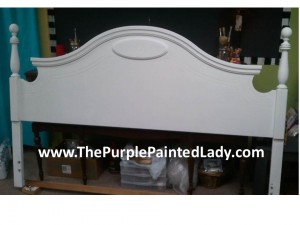A LITTLE Q & A: PURE WHITE Chalk Paint™ question.
A very dear customer of mine asked…..Someone brought me some pieces to paint and said they want them WHITE. I have used old white several times, but I’m just ordering “pure white”. Do you have any suggestions? They’ve asked for a white, white piece lightly distressed. That’s my goal.
The Purple Painted Lady’s response:
(First- I apologize for the lousy photo. It was taken with my cell phone.)
You will want to use Pure White Chalk Paint™ Decorative Paint by Annie Sloan- like you ordered.
I did a king size headboard at Christmas for a woman and it came out great. Something I did not do ….and that I should have- was shellac’d the furniture using Zinsser prior to painting with the Pure White Chalk Paint™. I would have used less paint!!!
Now keep in mind- when painting a piece WHITE…and wanting that bright white..even after shellac…an average of 2 coats will be needed. So, when you compare the cost of paint to shellac = it is worth the extra step for the shellac. (and if you can spray the shellac it will not add much time to your process) This example I share was based on that in December I painted a maple wood bed. Depending on what you are painting over, some colors that have less pigment – like Pure White will require what I shared above. This is not always needed- but there are examples that will and it is important to know that.
Questions that I would have back for my customer were:
What is the state of the furniture now?
Does the customer understand- that whatever the base is- will be what you see slightly once distressed? Make sure that is ok and I don’t know about you- but I always write up a very detailed contract for custom jobs!
Lastly, for those of you who paint for others….If you can have the customer find “inspiration” photos on line that you can reference in understanding what their “end vision” is- it is extremely helpful and I recommend incorporating those photos in the contract! Otherwise- and often- people have a difficult time articulating their thoughts and you do not realize they wanted “B” until you have invested time and materials creating “A.”
To explain my comment further above where I state that the shellac can help in using less paint …I mean in the sense that many people will write me and say- I am getting bleeding through the paint from the wood underneath. Then they will share that they are on the 4th coat of paint!!!! WHOA! This is where I say, “back away from the paint brush!” Sometimes- it doesn’t matter how many coats of paint you applied- there is an issue beneath that the paint cannot prevent. (that sometimes happens) So, as soon as you start to see wood tannins bleeding or stain seeping through- shellac is TYPICALLY going to help you. Shellac is an ideal sealer…where polyurethane (I am about to answer a question I received from The Country Nook in Rochester, NY now. Check out their Facebook page by the way.) …Polyurethane is best to protect from abrasion…not sealing. Shellac is used both as a furniture finish (and a very good one) and sealer (both for furniture and covering spots that you think might bleed through paint). Don’t buy more shellac than you have to use in a short time. It will spoil in the can and if you open a can of spoiled shellac, it will smell to high heaven . One of the reasons I love the spray …or the quart sizes. I recommend shellac..Zinsser Shellac since that is what I use and have been happy with the results. As for polyurethane- it gives an incredibly hard finish…. some polys can take up to at least 8 hours to dry, thus gathering all of the bugs and dust that will be available during that time. Again shellacs are great for sealing.

